Economic Assignment: Analyzing Economic Development Issues
VerifiedAdded on 2023/06/09
|11
|2061
|432
Report
AI Summary
This report addresses key questions in development economics, focusing on the importance of agriculture, population dynamics, and economic planning in developing nations. The assignment begins by emphasizing the critical role of agricultural systems, particularly peasant agriculture, in national development. It then examines the interconnected issues of population growth, poverty, and land pressures, exploring how these factors can create a vicious cycle of underdevelopment. Finally, the report analyzes the rationale behind development planning in developing countries, discussing market failures, resource mobilization, and the psychological impacts of planning. The report provides a comprehensive overview of these economic challenges and potential solutions, drawing upon relevant economic theories and real-world examples to illustrate the complexities of economic development.
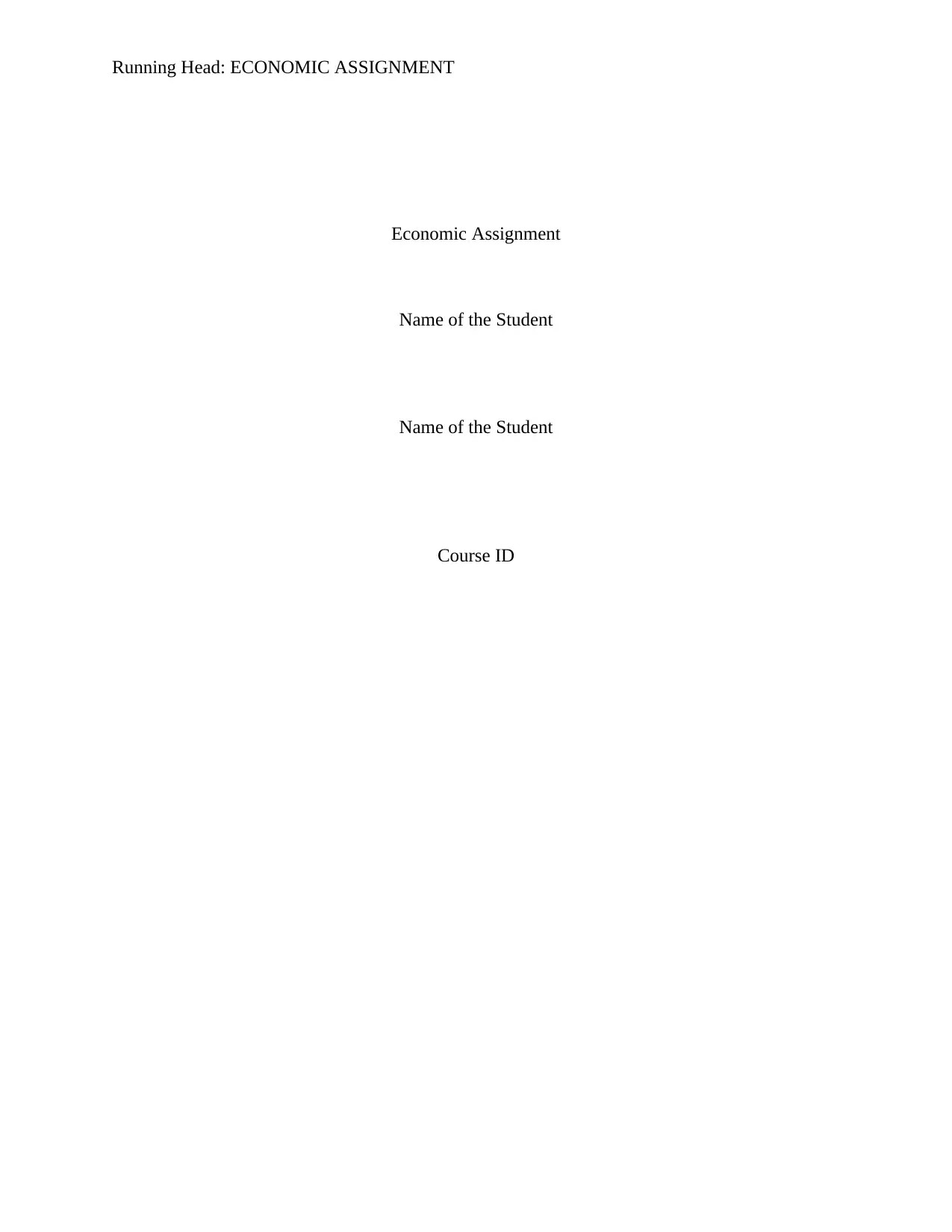
Running Head: ECONOMIC ASSIGNMENT
Economic Assignment
Name of the Student
Name of the Student
Course ID
Economic Assignment
Name of the Student
Name of the Student
Course ID
Paraphrase This Document
Need a fresh take? Get an instant paraphrase of this document with our AI Paraphraser
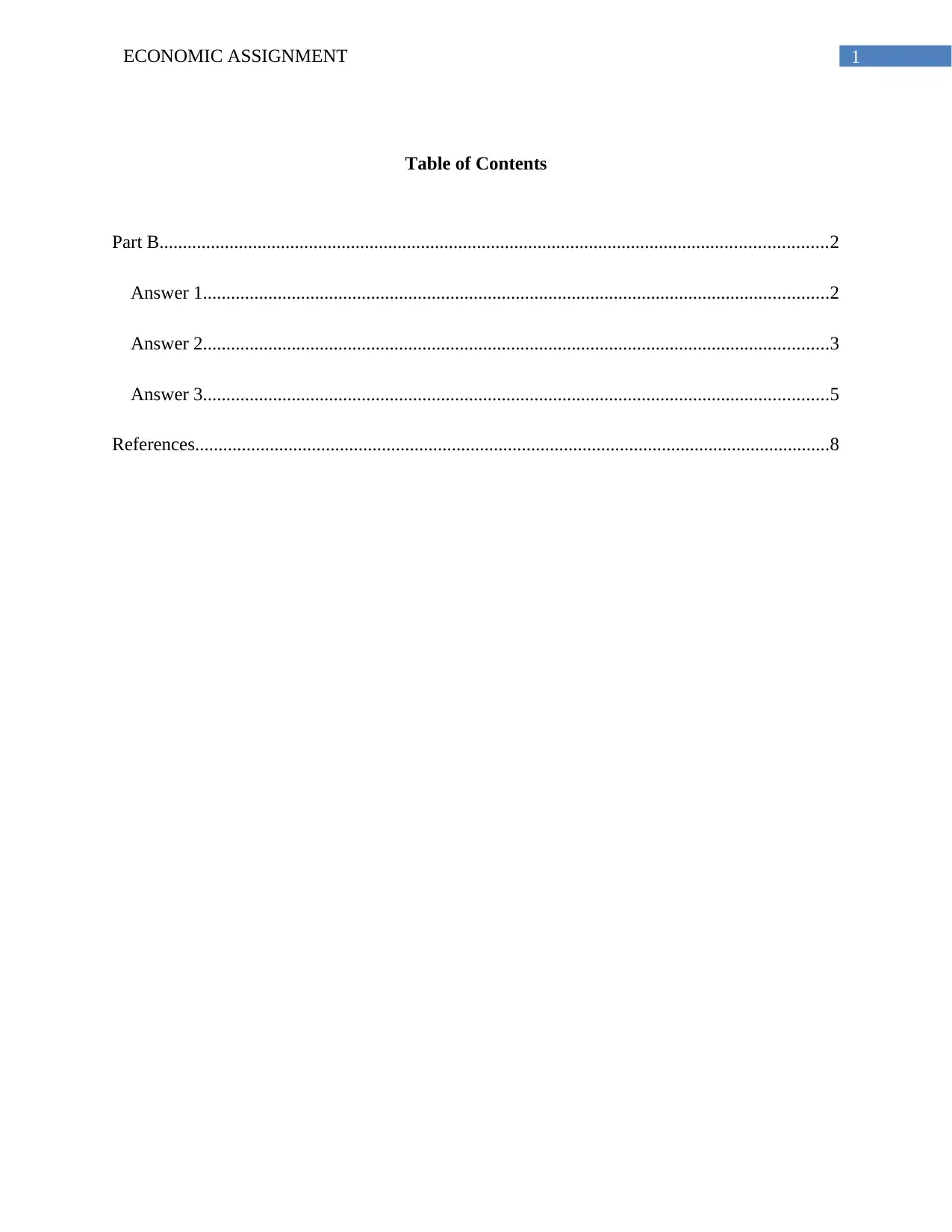
1ECONOMIC ASSIGNMENT
Table of Contents
Part B...............................................................................................................................................2
Answer 1......................................................................................................................................2
Answer 2......................................................................................................................................3
Answer 3......................................................................................................................................5
References........................................................................................................................................8
Table of Contents
Part B...............................................................................................................................................2
Answer 1......................................................................................................................................2
Answer 2......................................................................................................................................3
Answer 3......................................................................................................................................5
References........................................................................................................................................8

2ECONOMIC ASSIGNMENT
Part B
Answer 1
The development economists today place great emphasis on study of agriculture. The
have realized that the sector part from having a supportive role play a crucial role in economic
progress of a nation. The agricultural sector and rural economy is of particular importance for
lower income less developed and developing nations. There are three basic elements of an
agriculture based economic development strategy. First, it focuses on accelerating growth
through development of institutional, technological and price incentives to farmers (Sunley and
Martin 2017). It particularly aims to increase productivity of small and marginal farmers.
Second, it considers growing demand for agricultural output based on an employment oriented
strategy of urban development. Third, the study is limited to the agriculture and rural sector of
developing economies. The objective is to evaluate a diversified, nonagricultural and labor
intensive rural development program that can provide direct and indirect support agriculture and
farmers. Farmers should also support such program.
` In national development, study of agriculture and rural economy thus is considered as an
integral part. In developing economies, several industries are also dependent on agricultural
sector. Without an integrated rural development, industry based economic growth would be
interrupted. Even if it is successful, it can lead to internal imbalance in the economy (Thirlwall
and Pacheco-López 2017). The resulted imbalance can aggravate already existing problem of
poverty, unemployment and inequality. There are six primary aspects related agriculture and
rural development that can that connects the sector to national development.
Part B
Answer 1
The development economists today place great emphasis on study of agriculture. The
have realized that the sector part from having a supportive role play a crucial role in economic
progress of a nation. The agricultural sector and rural economy is of particular importance for
lower income less developed and developing nations. There are three basic elements of an
agriculture based economic development strategy. First, it focuses on accelerating growth
through development of institutional, technological and price incentives to farmers (Sunley and
Martin 2017). It particularly aims to increase productivity of small and marginal farmers.
Second, it considers growing demand for agricultural output based on an employment oriented
strategy of urban development. Third, the study is limited to the agriculture and rural sector of
developing economies. The objective is to evaluate a diversified, nonagricultural and labor
intensive rural development program that can provide direct and indirect support agriculture and
farmers. Farmers should also support such program.
` In national development, study of agriculture and rural economy thus is considered as an
integral part. In developing economies, several industries are also dependent on agricultural
sector. Without an integrated rural development, industry based economic growth would be
interrupted. Even if it is successful, it can lead to internal imbalance in the economy (Thirlwall
and Pacheco-López 2017). The resulted imbalance can aggravate already existing problem of
poverty, unemployment and inequality. There are six primary aspects related agriculture and
rural development that can that connects the sector to national development.
⊘ This is a preview!⊘
Do you want full access?
Subscribe today to unlock all pages.

Trusted by 1+ million students worldwide
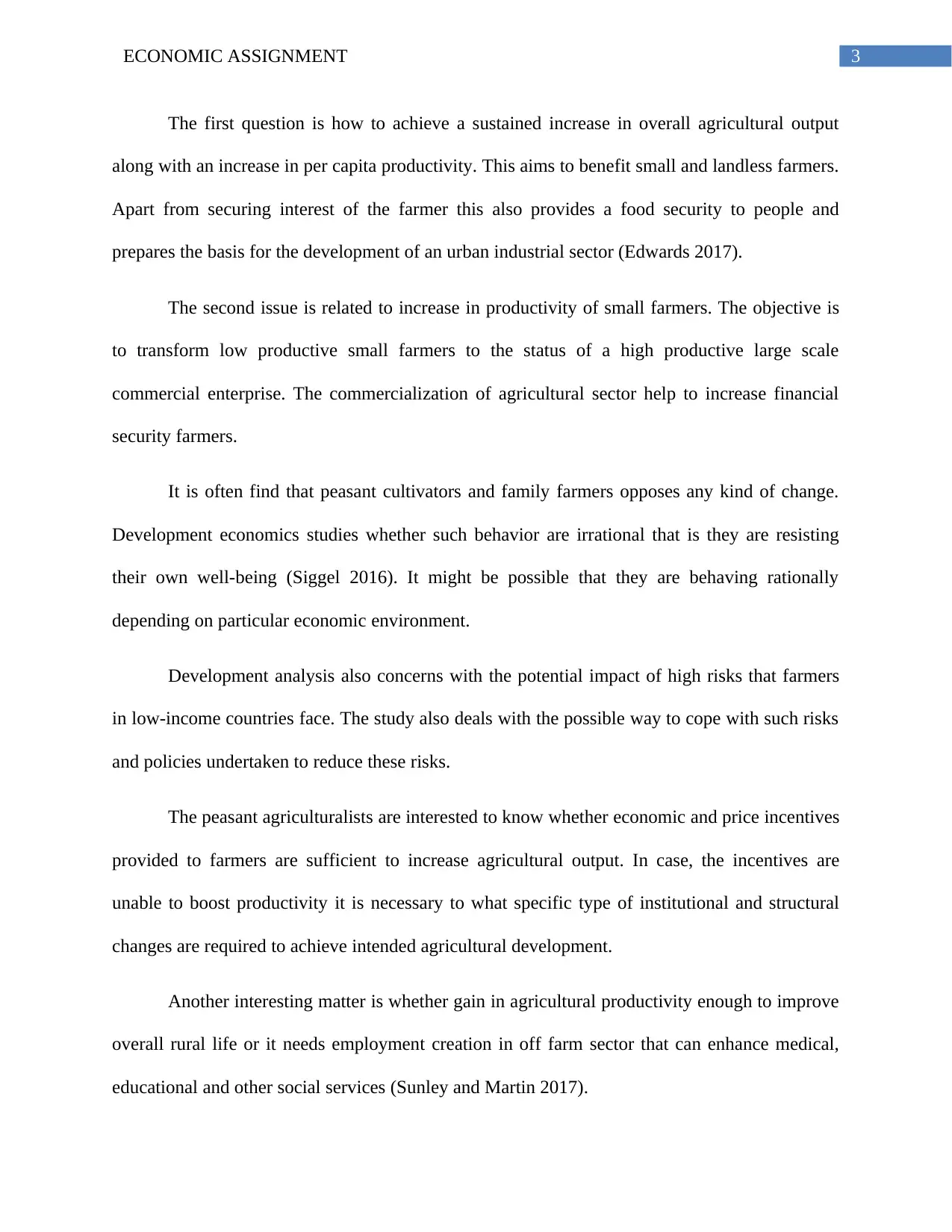
3ECONOMIC ASSIGNMENT
The first question is how to achieve a sustained increase in overall agricultural output
along with an increase in per capita productivity. This aims to benefit small and landless farmers.
Apart from securing interest of the farmer this also provides a food security to people and
prepares the basis for the development of an urban industrial sector (Edwards 2017).
The second issue is related to increase in productivity of small farmers. The objective is
to transform low productive small farmers to the status of a high productive large scale
commercial enterprise. The commercialization of agricultural sector help to increase financial
security farmers.
It is often find that peasant cultivators and family farmers opposes any kind of change.
Development economics studies whether such behavior are irrational that is they are resisting
their own well-being (Siggel 2016). It might be possible that they are behaving rationally
depending on particular economic environment.
Development analysis also concerns with the potential impact of high risks that farmers
in low-income countries face. The study also deals with the possible way to cope with such risks
and policies undertaken to reduce these risks.
The peasant agriculturalists are interested to know whether economic and price incentives
provided to farmers are sufficient to increase agricultural output. In case, the incentives are
unable to boost productivity it is necessary to what specific type of institutional and structural
changes are required to achieve intended agricultural development.
Another interesting matter is whether gain in agricultural productivity enough to improve
overall rural life or it needs employment creation in off farm sector that can enhance medical,
educational and other social services (Sunley and Martin 2017).
The first question is how to achieve a sustained increase in overall agricultural output
along with an increase in per capita productivity. This aims to benefit small and landless farmers.
Apart from securing interest of the farmer this also provides a food security to people and
prepares the basis for the development of an urban industrial sector (Edwards 2017).
The second issue is related to increase in productivity of small farmers. The objective is
to transform low productive small farmers to the status of a high productive large scale
commercial enterprise. The commercialization of agricultural sector help to increase financial
security farmers.
It is often find that peasant cultivators and family farmers opposes any kind of change.
Development economics studies whether such behavior are irrational that is they are resisting
their own well-being (Siggel 2016). It might be possible that they are behaving rationally
depending on particular economic environment.
Development analysis also concerns with the potential impact of high risks that farmers
in low-income countries face. The study also deals with the possible way to cope with such risks
and policies undertaken to reduce these risks.
The peasant agriculturalists are interested to know whether economic and price incentives
provided to farmers are sufficient to increase agricultural output. In case, the incentives are
unable to boost productivity it is necessary to what specific type of institutional and structural
changes are required to achieve intended agricultural development.
Another interesting matter is whether gain in agricultural productivity enough to improve
overall rural life or it needs employment creation in off farm sector that can enhance medical,
educational and other social services (Sunley and Martin 2017).
Paraphrase This Document
Need a fresh take? Get an instant paraphrase of this document with our AI Paraphraser

4ECONOMIC ASSIGNMENT
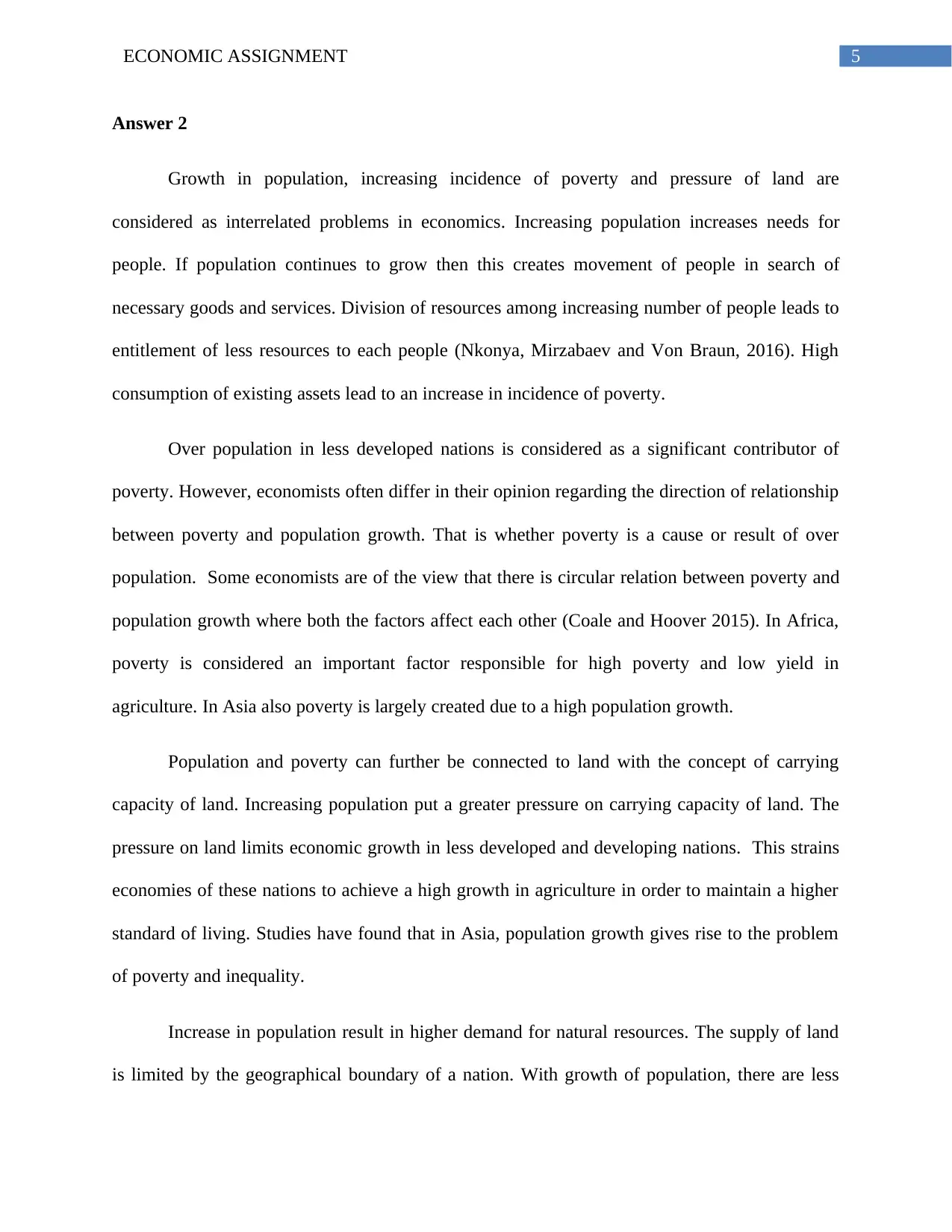
5ECONOMIC ASSIGNMENT
Answer 2
Growth in population, increasing incidence of poverty and pressure of land are
considered as interrelated problems in economics. Increasing population increases needs for
people. If population continues to grow then this creates movement of people in search of
necessary goods and services. Division of resources among increasing number of people leads to
entitlement of less resources to each people (Nkonya, Mirzabaev and Von Braun, 2016). High
consumption of existing assets lead to an increase in incidence of poverty.
Over population in less developed nations is considered as a significant contributor of
poverty. However, economists often differ in their opinion regarding the direction of relationship
between poverty and population growth. That is whether poverty is a cause or result of over
population. Some economists are of the view that there is circular relation between poverty and
population growth where both the factors affect each other (Coale and Hoover 2015). In Africa,
poverty is considered an important factor responsible for high poverty and low yield in
agriculture. In Asia also poverty is largely created due to a high population growth.
Population and poverty can further be connected to land with the concept of carrying
capacity of land. Increasing population put a greater pressure on carrying capacity of land. The
pressure on land limits economic growth in less developed and developing nations. This strains
economies of these nations to achieve a high growth in agriculture in order to maintain a higher
standard of living. Studies have found that in Asia, population growth gives rise to the problem
of poverty and inequality.
Increase in population result in higher demand for natural resources. The supply of land
is limited by the geographical boundary of a nation. With growth of population, there are less
Answer 2
Growth in population, increasing incidence of poverty and pressure of land are
considered as interrelated problems in economics. Increasing population increases needs for
people. If population continues to grow then this creates movement of people in search of
necessary goods and services. Division of resources among increasing number of people leads to
entitlement of less resources to each people (Nkonya, Mirzabaev and Von Braun, 2016). High
consumption of existing assets lead to an increase in incidence of poverty.
Over population in less developed nations is considered as a significant contributor of
poverty. However, economists often differ in their opinion regarding the direction of relationship
between poverty and population growth. That is whether poverty is a cause or result of over
population. Some economists are of the view that there is circular relation between poverty and
population growth where both the factors affect each other (Coale and Hoover 2015). In Africa,
poverty is considered an important factor responsible for high poverty and low yield in
agriculture. In Asia also poverty is largely created due to a high population growth.
Population and poverty can further be connected to land with the concept of carrying
capacity of land. Increasing population put a greater pressure on carrying capacity of land. The
pressure on land limits economic growth in less developed and developing nations. This strains
economies of these nations to achieve a high growth in agriculture in order to maintain a higher
standard of living. Studies have found that in Asia, population growth gives rise to the problem
of poverty and inequality.
Increase in population result in higher demand for natural resources. The supply of land
is limited by the geographical boundary of a nation. With growth of population, there are less
⊘ This is a preview!⊘
Do you want full access?
Subscribe today to unlock all pages.

Trusted by 1+ million students worldwide
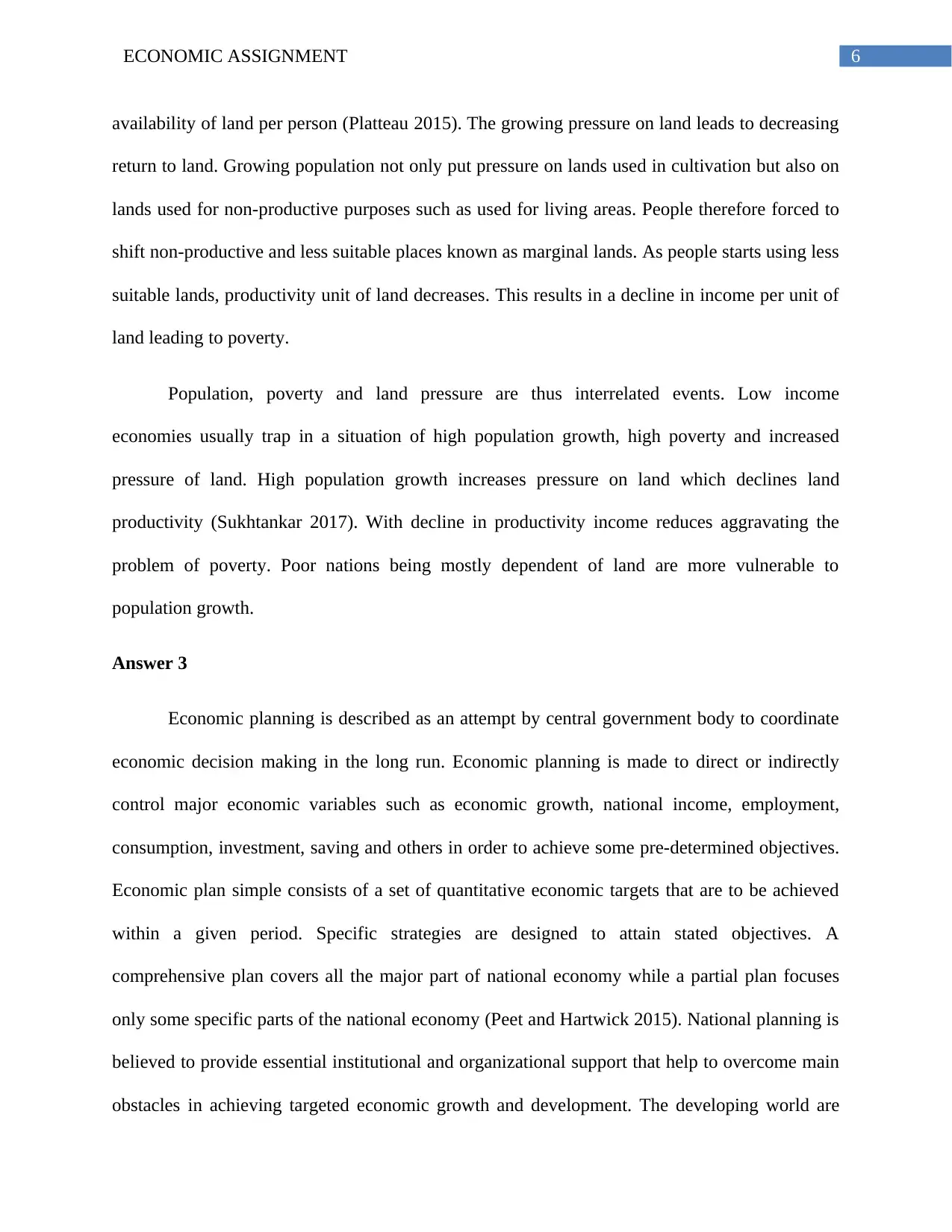
6ECONOMIC ASSIGNMENT
availability of land per person (Platteau 2015). The growing pressure on land leads to decreasing
return to land. Growing population not only put pressure on lands used in cultivation but also on
lands used for non-productive purposes such as used for living areas. People therefore forced to
shift non-productive and less suitable places known as marginal lands. As people starts using less
suitable lands, productivity unit of land decreases. This results in a decline in income per unit of
land leading to poverty.
Population, poverty and land pressure are thus interrelated events. Low income
economies usually trap in a situation of high population growth, high poverty and increased
pressure of land. High population growth increases pressure on land which declines land
productivity (Sukhtankar 2017). With decline in productivity income reduces aggravating the
problem of poverty. Poor nations being mostly dependent of land are more vulnerable to
population growth.
Answer 3
Economic planning is described as an attempt by central government body to coordinate
economic decision making in the long run. Economic planning is made to direct or indirectly
control major economic variables such as economic growth, national income, employment,
consumption, investment, saving and others in order to achieve some pre-determined objectives.
Economic plan simple consists of a set of quantitative economic targets that are to be achieved
within a given period. Specific strategies are designed to attain stated objectives. A
comprehensive plan covers all the major part of national economy while a partial plan focuses
only some specific parts of the national economy (Peet and Hartwick 2015). National planning is
believed to provide essential institutional and organizational support that help to overcome main
obstacles in achieving targeted economic growth and development. The developing world are
availability of land per person (Platteau 2015). The growing pressure on land leads to decreasing
return to land. Growing population not only put pressure on lands used in cultivation but also on
lands used for non-productive purposes such as used for living areas. People therefore forced to
shift non-productive and less suitable places known as marginal lands. As people starts using less
suitable lands, productivity unit of land decreases. This results in a decline in income per unit of
land leading to poverty.
Population, poverty and land pressure are thus interrelated events. Low income
economies usually trap in a situation of high population growth, high poverty and increased
pressure of land. High population growth increases pressure on land which declines land
productivity (Sukhtankar 2017). With decline in productivity income reduces aggravating the
problem of poverty. Poor nations being mostly dependent of land are more vulnerable to
population growth.
Answer 3
Economic planning is described as an attempt by central government body to coordinate
economic decision making in the long run. Economic planning is made to direct or indirectly
control major economic variables such as economic growth, national income, employment,
consumption, investment, saving and others in order to achieve some pre-determined objectives.
Economic plan simple consists of a set of quantitative economic targets that are to be achieved
within a given period. Specific strategies are designed to attain stated objectives. A
comprehensive plan covers all the major part of national economy while a partial plan focuses
only some specific parts of the national economy (Peet and Hartwick 2015). National planning is
believed to provide essential institutional and organizational support that help to overcome main
obstacles in achieving targeted economic growth and development. The developing world are
Paraphrase This Document
Need a fresh take? Get an instant paraphrase of this document with our AI Paraphraser
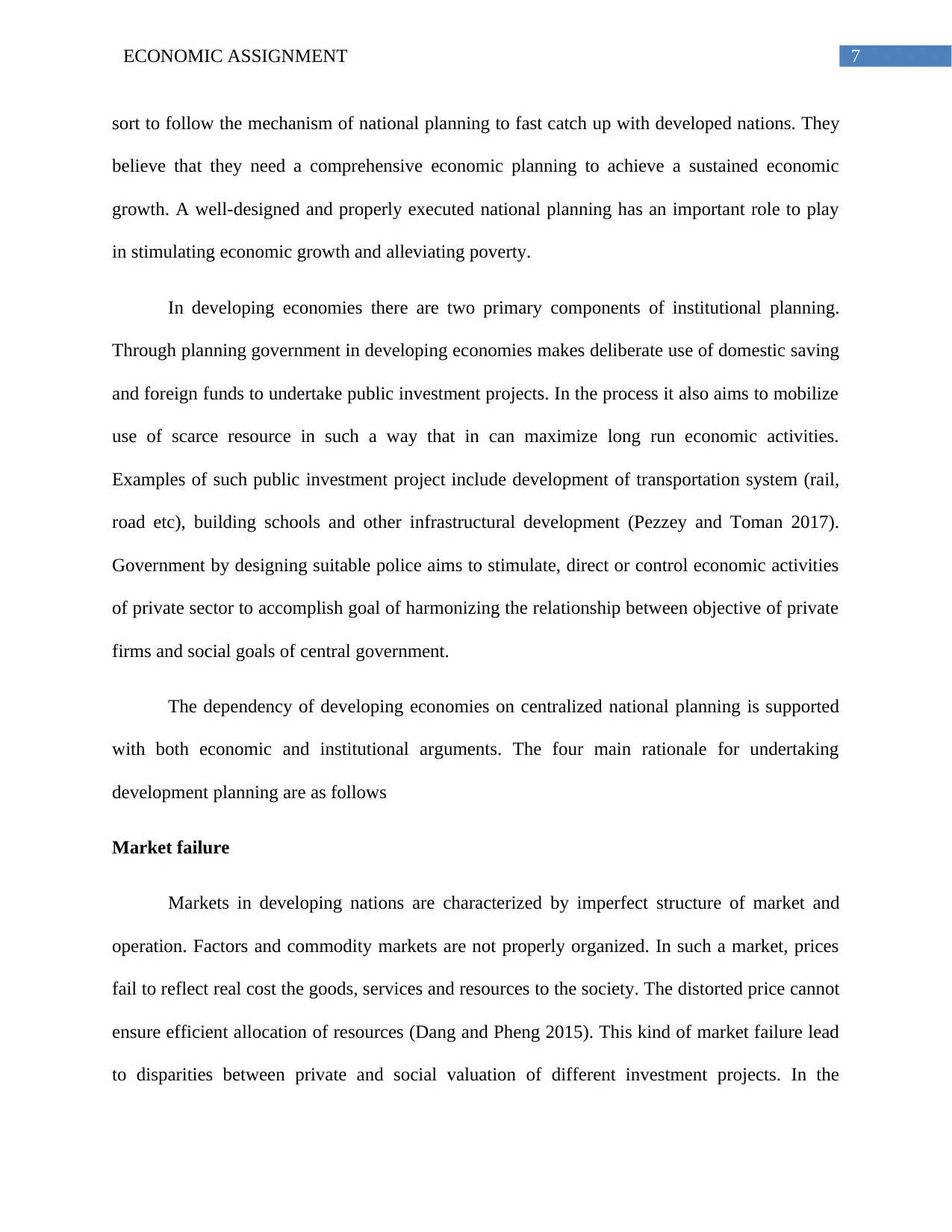
7ECONOMIC ASSIGNMENT
sort to follow the mechanism of national planning to fast catch up with developed nations. They
believe that they need a comprehensive economic planning to achieve a sustained economic
growth. A well-designed and properly executed national planning has an important role to play
in stimulating economic growth and alleviating poverty.
In developing economies there are two primary components of institutional planning.
Through planning government in developing economies makes deliberate use of domestic saving
and foreign funds to undertake public investment projects. In the process it also aims to mobilize
use of scarce resource in such a way that in can maximize long run economic activities.
Examples of such public investment project include development of transportation system (rail,
road etc), building schools and other infrastructural development (Pezzey and Toman 2017).
Government by designing suitable police aims to stimulate, direct or control economic activities
of private sector to accomplish goal of harmonizing the relationship between objective of private
firms and social goals of central government.
The dependency of developing economies on centralized national planning is supported
with both economic and institutional arguments. The four main rationale for undertaking
development planning are as follows
Market failure
Markets in developing nations are characterized by imperfect structure of market and
operation. Factors and commodity markets are not properly organized. In such a market, prices
fail to reflect real cost the goods, services and resources to the society. The distorted price cannot
ensure efficient allocation of resources (Dang and Pheng 2015). This kind of market failure lead
to disparities between private and social valuation of different investment projects. In the
sort to follow the mechanism of national planning to fast catch up with developed nations. They
believe that they need a comprehensive economic planning to achieve a sustained economic
growth. A well-designed and properly executed national planning has an important role to play
in stimulating economic growth and alleviating poverty.
In developing economies there are two primary components of institutional planning.
Through planning government in developing economies makes deliberate use of domestic saving
and foreign funds to undertake public investment projects. In the process it also aims to mobilize
use of scarce resource in such a way that in can maximize long run economic activities.
Examples of such public investment project include development of transportation system (rail,
road etc), building schools and other infrastructural development (Pezzey and Toman 2017).
Government by designing suitable police aims to stimulate, direct or control economic activities
of private sector to accomplish goal of harmonizing the relationship between objective of private
firms and social goals of central government.
The dependency of developing economies on centralized national planning is supported
with both economic and institutional arguments. The four main rationale for undertaking
development planning are as follows
Market failure
Markets in developing nations are characterized by imperfect structure of market and
operation. Factors and commodity markets are not properly organized. In such a market, prices
fail to reflect real cost the goods, services and resources to the society. The distorted price cannot
ensure efficient allocation of resources (Dang and Pheng 2015). This kind of market failure lead
to disparities between private and social valuation of different investment projects. In the
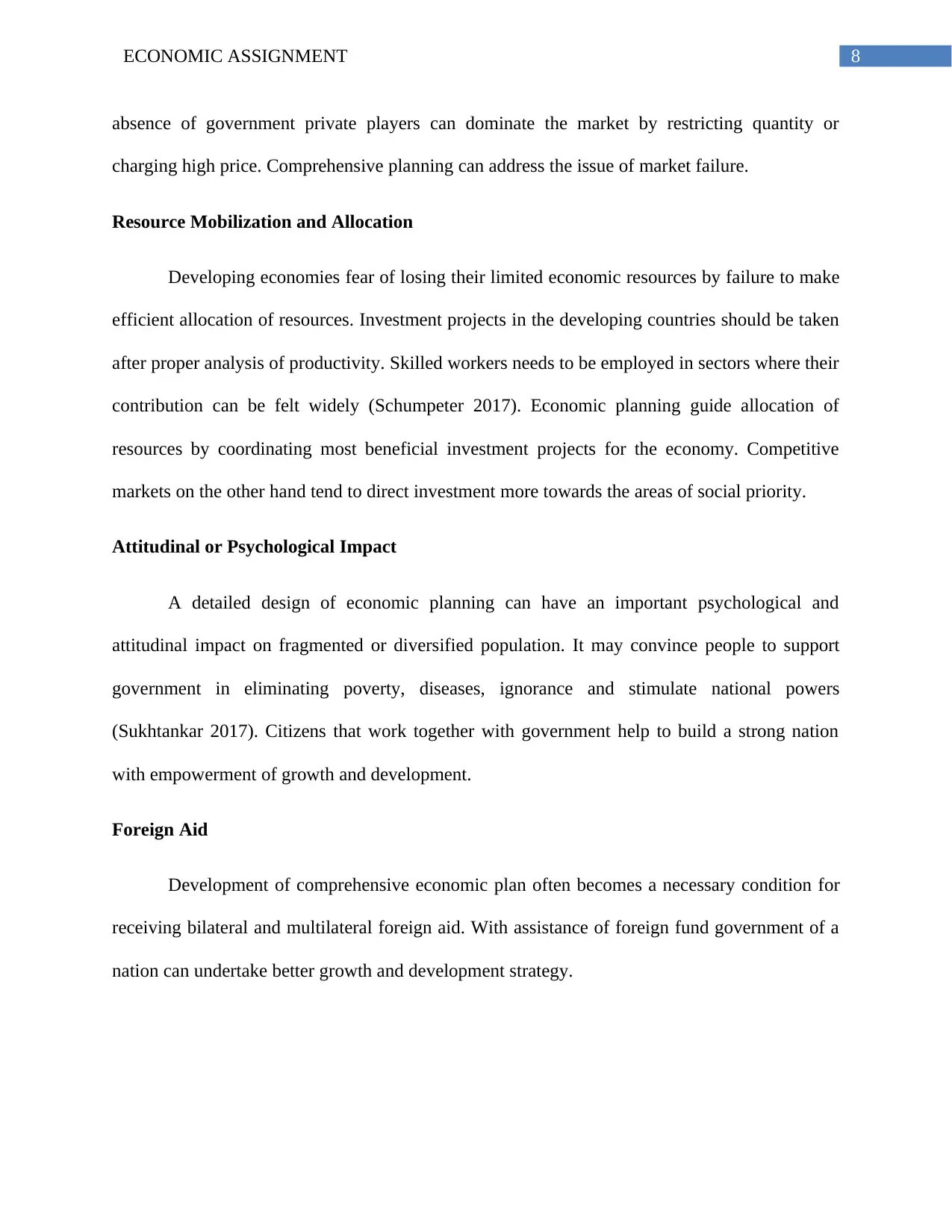
8ECONOMIC ASSIGNMENT
absence of government private players can dominate the market by restricting quantity or
charging high price. Comprehensive planning can address the issue of market failure.
Resource Mobilization and Allocation
Developing economies fear of losing their limited economic resources by failure to make
efficient allocation of resources. Investment projects in the developing countries should be taken
after proper analysis of productivity. Skilled workers needs to be employed in sectors where their
contribution can be felt widely (Schumpeter 2017). Economic planning guide allocation of
resources by coordinating most beneficial investment projects for the economy. Competitive
markets on the other hand tend to direct investment more towards the areas of social priority.
Attitudinal or Psychological Impact
A detailed design of economic planning can have an important psychological and
attitudinal impact on fragmented or diversified population. It may convince people to support
government in eliminating poverty, diseases, ignorance and stimulate national powers
(Sukhtankar 2017). Citizens that work together with government help to build a strong nation
with empowerment of growth and development.
Foreign Aid
Development of comprehensive economic plan often becomes a necessary condition for
receiving bilateral and multilateral foreign aid. With assistance of foreign fund government of a
nation can undertake better growth and development strategy.
absence of government private players can dominate the market by restricting quantity or
charging high price. Comprehensive planning can address the issue of market failure.
Resource Mobilization and Allocation
Developing economies fear of losing their limited economic resources by failure to make
efficient allocation of resources. Investment projects in the developing countries should be taken
after proper analysis of productivity. Skilled workers needs to be employed in sectors where their
contribution can be felt widely (Schumpeter 2017). Economic planning guide allocation of
resources by coordinating most beneficial investment projects for the economy. Competitive
markets on the other hand tend to direct investment more towards the areas of social priority.
Attitudinal or Psychological Impact
A detailed design of economic planning can have an important psychological and
attitudinal impact on fragmented or diversified population. It may convince people to support
government in eliminating poverty, diseases, ignorance and stimulate national powers
(Sukhtankar 2017). Citizens that work together with government help to build a strong nation
with empowerment of growth and development.
Foreign Aid
Development of comprehensive economic plan often becomes a necessary condition for
receiving bilateral and multilateral foreign aid. With assistance of foreign fund government of a
nation can undertake better growth and development strategy.
⊘ This is a preview!⊘
Do you want full access?
Subscribe today to unlock all pages.

Trusted by 1+ million students worldwide
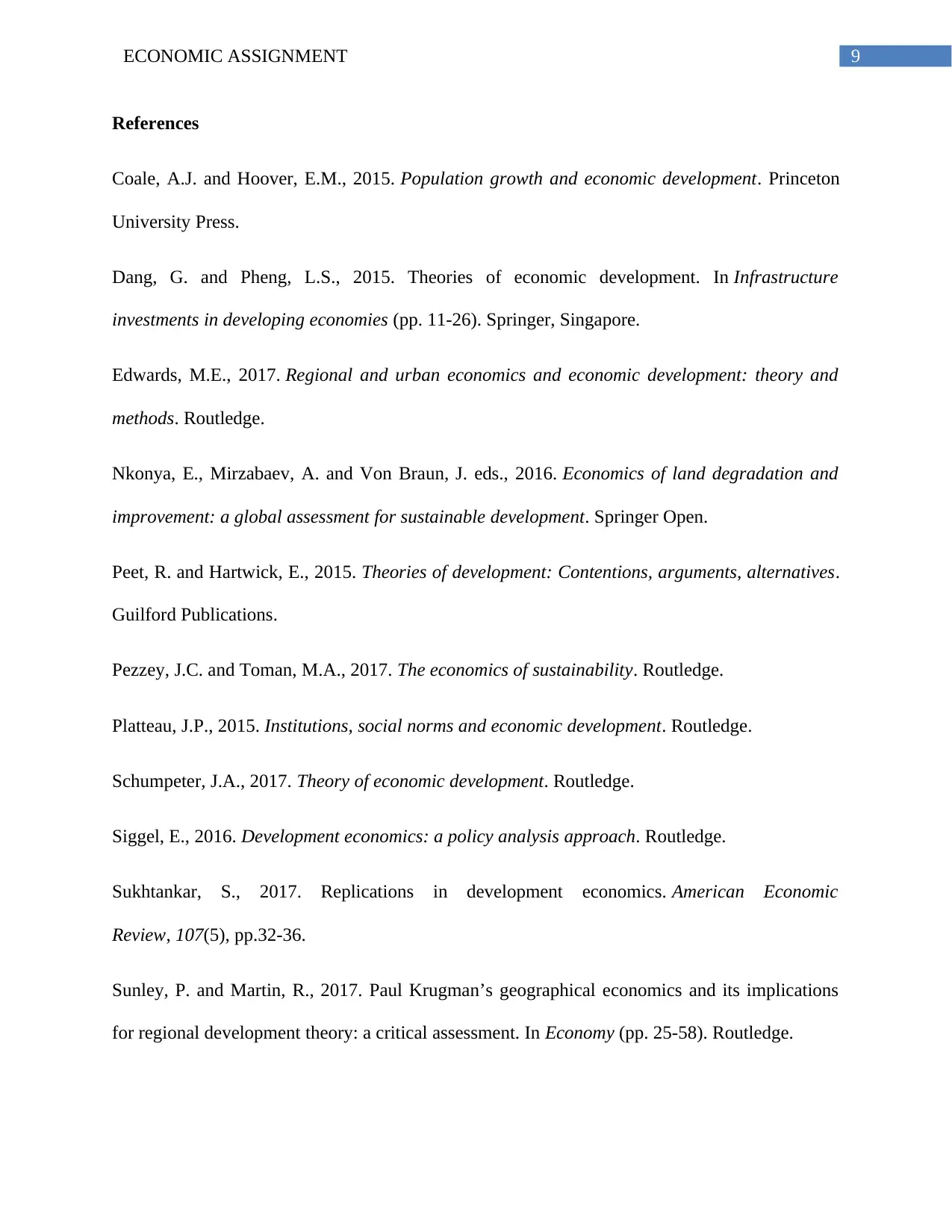
9ECONOMIC ASSIGNMENT
References
Coale, A.J. and Hoover, E.M., 2015. Population growth and economic development. Princeton
University Press.
Dang, G. and Pheng, L.S., 2015. Theories of economic development. In Infrastructure
investments in developing economies (pp. 11-26). Springer, Singapore.
Edwards, M.E., 2017. Regional and urban economics and economic development: theory and
methods. Routledge.
Nkonya, E., Mirzabaev, A. and Von Braun, J. eds., 2016. Economics of land degradation and
improvement: a global assessment for sustainable development. Springer Open.
Peet, R. and Hartwick, E., 2015. Theories of development: Contentions, arguments, alternatives.
Guilford Publications.
Pezzey, J.C. and Toman, M.A., 2017. The economics of sustainability. Routledge.
Platteau, J.P., 2015. Institutions, social norms and economic development. Routledge.
Schumpeter, J.A., 2017. Theory of economic development. Routledge.
Siggel, E., 2016. Development economics: a policy analysis approach. Routledge.
Sukhtankar, S., 2017. Replications in development economics. American Economic
Review, 107(5), pp.32-36.
Sunley, P. and Martin, R., 2017. Paul Krugman’s geographical economics and its implications
for regional development theory: a critical assessment. In Economy (pp. 25-58). Routledge.
References
Coale, A.J. and Hoover, E.M., 2015. Population growth and economic development. Princeton
University Press.
Dang, G. and Pheng, L.S., 2015. Theories of economic development. In Infrastructure
investments in developing economies (pp. 11-26). Springer, Singapore.
Edwards, M.E., 2017. Regional and urban economics and economic development: theory and
methods. Routledge.
Nkonya, E., Mirzabaev, A. and Von Braun, J. eds., 2016. Economics of land degradation and
improvement: a global assessment for sustainable development. Springer Open.
Peet, R. and Hartwick, E., 2015. Theories of development: Contentions, arguments, alternatives.
Guilford Publications.
Pezzey, J.C. and Toman, M.A., 2017. The economics of sustainability. Routledge.
Platteau, J.P., 2015. Institutions, social norms and economic development. Routledge.
Schumpeter, J.A., 2017. Theory of economic development. Routledge.
Siggel, E., 2016. Development economics: a policy analysis approach. Routledge.
Sukhtankar, S., 2017. Replications in development economics. American Economic
Review, 107(5), pp.32-36.
Sunley, P. and Martin, R., 2017. Paul Krugman’s geographical economics and its implications
for regional development theory: a critical assessment. In Economy (pp. 25-58). Routledge.
Paraphrase This Document
Need a fresh take? Get an instant paraphrase of this document with our AI Paraphraser

10ECONOMIC ASSIGNMENT
Thirlwall, A.P. and Pacheco-López, P., 2017. Economics of development: theory and evidence.
Palgrave.
Thirlwall, A.P. and Pacheco-López, P., 2017. Economics of development: theory and evidence.
Palgrave.
1 out of 11
Related Documents
Your All-in-One AI-Powered Toolkit for Academic Success.
+13062052269
info@desklib.com
Available 24*7 on WhatsApp / Email
![[object Object]](/_next/static/media/star-bottom.7253800d.svg)
Unlock your academic potential
Copyright © 2020–2025 A2Z Services. All Rights Reserved. Developed and managed by ZUCOL.




